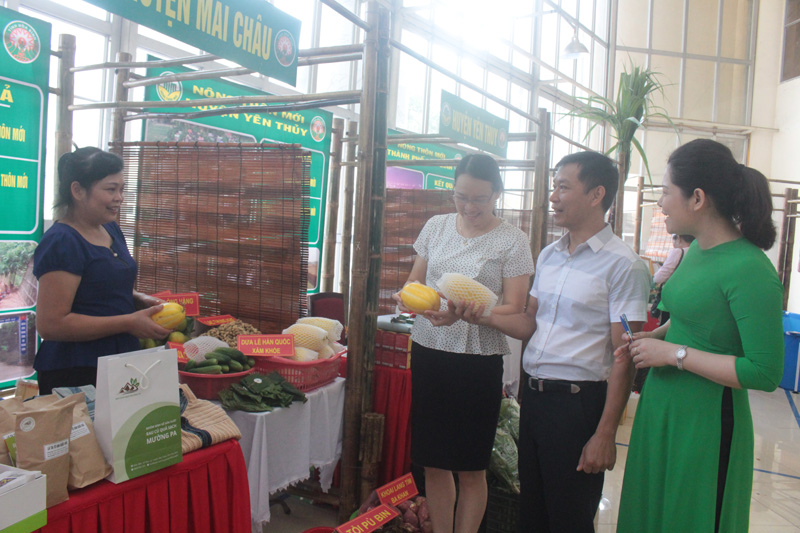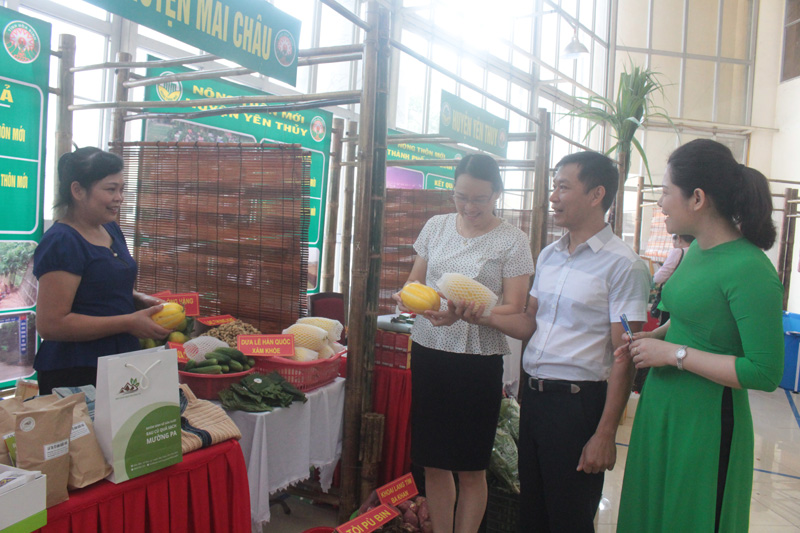
(HBO) - Recently, the variety of the super sweet melon originating in Korea has been popular among the consumers thanks to its characteristic delicious flavor, high nutritional content and cool sweetness. This specialty fruit has also appeared in the provincial market. In addition to the imported sources, the Korean melon also has the inter-provincial origin with the existing model in Xam Khoe commune (Mai Chau).
 The consumers in Hoa Binh City have been paying attention to Korean melon grown in the model in Xam Khoe commune (Mai Chau).
The consumers in Hoa Binh City have been paying attention to Korean melon grown in the model in Xam Khoe commune (Mai Chau).
Being deployed with the support of seeds and techniques from Good Neighbors International (GNJ), the model was introduced with the aim of improving the livelihoods of indigenous peoples in the project area and the products targeting the more potential and wider consumer market. Before that, the life of the farmers in Xam Khoe commune depended on agriculture. The main crop products were rice and different kinds of vegetables, beans, peppers, herb vegetables, cucumbers, etc. Ten households in 2 hamlets, Sun and Xuan Tien have taken part in the model of growing the Korean melon.
Familiarizing with the farming techniques, strictly following the steps and planting in high-tech net houses are the initial surprises that the households must follow when participating in the model. In return, the deployment of model trials has achieved the positive results.
On the area of 1,000 m2 of garden land, Mr. Ha Van Thoan in the Sun hamlet used to grow chili but the productivity was not high, the output market was not stable. Being promoted and instructed by the GNJ organization, he bravely converted to planting the Korean melon. With the suitable soil condition, for the melon to well grow, he has been making high beds and covering with the protective plastic, focusing on caring, fertilizing, limiting rats and pests. The melon after each crop has a nice design with better quality.
Similarly, Mr. Ha Van Thu from Sun hamlet has also converted the inefficient agricultural land to planting the Korean melon. The practice following the technical steps guided by the GNJ organization has brought the encouraging results. The price of this commodity at the beginning or the end of the season is up to 50,000 - 60,000 VND a kg, the main crop is 30,000 VND / kg. Each crop lasts 3 months, and farmers can plant 3 crops every year. The average income per hectare of cultivation is about 400-500 million VND each year.
The area of these short-term specialty crops has been replicated by the farmers in Xam Khoe commune from 2017. A Korean melon planting area has been built in a net house with an area of 1,500 m2 has been built in Xuan Tien and Sun hamlets. The total area of this specialty melon is 2 hectares in the 2019 crop.
GNJ not only provides the financial and technical support but it also connects the product consumption at major supermarkets in Hanoi for the households following the model. The products are popular in the market, so the consumption capacity is very high. The supply does not meet the demand with a stable purchase price of 30,000 VND a kg right in the garden. The average weight of each fruit is 0.5 - 0.7 kg, the fruit of type 1 can reach 1 - 1.2 kg.
Recently, the Korean melon produced by the farmers in Xam Khe commune was introduced and displayed in Hoa Binh. The products are favored by customers, and they cannot sufficiently supply. Mr. Lo Van Chung, an officer of the agriculture and land administration in Xam Khoe commune says that the model of planting the Korean melon has helped farmers maintain the natural farming combined with science and technology to improve the productivity and the value to improve the income, opening up the opportunities to access big markets. On that basis, the Party Committee and the local authorities have encouraged people to continue replicating the model in the next production seasons.
According to data from the Hoa Binh Provincial Party Committee, the industrial production index for the first six months of 2025 is estimated to have increased by 20% compared to the same period last year. This marks the highest year-on-year growth rate for this period since 2020.
In the first six months of 2025, Hoa Binh province’s export turnover was estimated at 1.145 billion USD, marking an 18.11% increase compared to the same period in 2024. Import turnover was estimated at $ 804 million, a 17.15% increase, which helped the province maintain a positive trade balance.
The lives of the ethnic minority farmers in Tan Lac district have gradually improved thanks to the new directions in agricultural production. This is a testament to the collective strength fostered through the professional associations and groups implemented by various levels of the district’s Farmers’ Union.
With the motto the "product quality comes first,” after nearly one year of establishment and operation, Muong village’s Clean Food Agricultural and Commercial Cooperative, located in Cau Hamlet, Hung Son Commune (Kim Boi district), has launched reputable, high-quality agricultural products to the market that are well-received by consumers. The products such as Muong village’s pork sausage, salt-cured chicken, and salt-cured pork hocks have gradually carved out a place in the market and they are on the path to obtaining the OCOP certification.
In the past, the phrase "bumper harvest, rock-bottom prices" was a familiar refrain for Vietnamese farmers engaged in fragmented, small-scale agriculture. But today, a new spirit is emerging across rural areas of Hoa Binh province - one of collaboration, organisation, and collective economic models that provide a stable foundation for production.
Maintaining growing area codes and packing facility codes in accordance with regulations is a mandatory requirement for agricultural products to be eligible for export. Recently, the Department of Agriculture and Environment of Hoa Binh province has intensified technical supervision of designated farming areas and packing facilities to safeguard the "green passport" that enables its products to access international markets.



 The consumers in Hoa Binh City have been paying attention to Korean melon grown in the model in Xam Khoe commune (Mai Chau).
The consumers in Hoa Binh City have been paying attention to Korean melon grown in the model in Xam Khoe commune (Mai Chau).